Southampton Passenger Lists 1893 - 1929
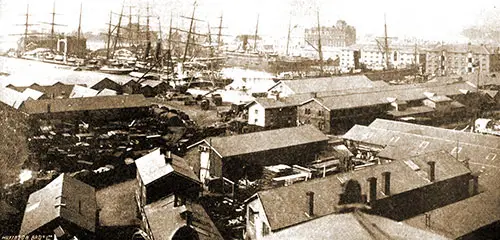
View of Inner Dock at Southampton in 1904. | GGA Image ID # 1756758d47
Southampton is the largest city in the ceremonial county of Hampshire on the south coast of England. It is situated 75 miles (121 km) southwest of London and 19 miles (31 km) northwest of Portsmouth. Southampton is a major port and the closest city to the New Forest. It lies at the northernmost point of Southampton Water at the confluence of the River Test and River Itchen, with the River Hamble joining to the south of the urban area.
In 1912, the RMS Titanic sailed from Southampton. Four of five crew members on board the vessel were Sotonians, with about a third of those who perished in the tragedy hailing from the city. Southampton was subsequently the home port for the transatlantic passenger services operated by Cunard with their Blue Riband liner RMS Queen Mary and her running mate RMS Queen Elizabeth.
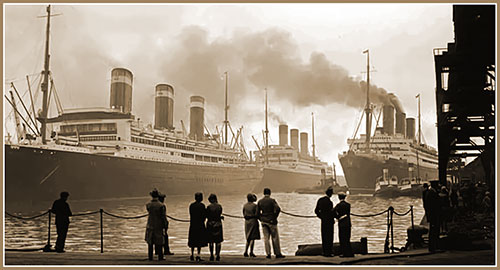
Three Former German Imperator Class Liners From Left to Right: SS Leviathan (Former SS Vaterland), RMS Majestic (Former SS Bismarck), and RMS Berengaria (Former SS Imperator) Photographed Side by Side at the Port of Southampton circa 1927. | GGA Image ID # 1d57fef6c7
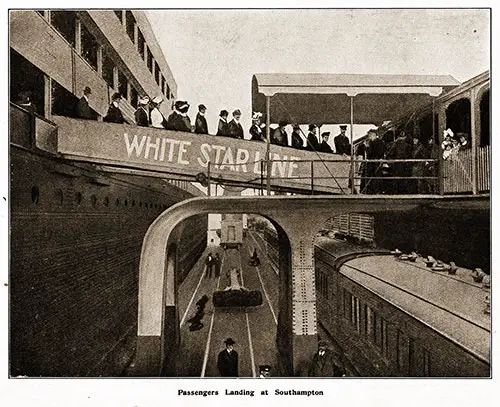
Passengers Landing at Southampton, Disembarking from a White Star Line Ocean Liner. Steamers of the White Star Line, 1909. From the Chris Crofts Collection. | GGA Image ID # 211033a99c
Note: Typically, only the origination and final destination ports are listed in each link. Other intermediary ports of call are not listed.
1890s
American Line 1890s
- 1893-06-03 SS New York - Southampton to New York
- 1893-08-19 SS New York - Southampton to New York
- 1895-09-07 SS Paris - Southampton to New York
- 1895-09-14 SS St. Louis - Southampton to New York
- 1896-04-22 SS Paris - New York to Southampton
- 1896-08-15 SS Paris - Southampton to New York
- 1896-09-05 SS Paris - Southampton to New York
- 1896-09-29 SS New York - Southampton to New York
- 1896-11-09 SS New York - Southampton to New York
- 1897-10-02 SS St. Louis - Southampton to New York
- 1899-08-12 SS New York - Southampton to New York
- 1899-10-18 SS St. Paul - New York to Southampton
- 1899-10-21 SS St. Louis - Southampton to New York
Hamburg American Line / Hamburg Amerika Linie (HAPAG) 1890s
North German Lloyd / Norddeutscher Lloyd 1890s
1900s
American Line 1900s
- 1900-09-08 SS New York - Southampton to New York
- 1901-05-25 SS St. Louis - Southampton to New York
- 1901-09-04 SS St. Louis - New York to Southampton
- 1901-09-28 SS St. Paul - Southampton to New York
- 1902-12-06 SS St. Paul - Southampton to New York
- 1903-09-12 SS Philadelphia - Southampton to New York
- 1904-02-27 SS New York - Southampton to New York
- 1904-12-10 SS St. Paul - Southampton to New York
- 1905-09-23 SS New York - Southampton to New York
- 1906-08-11 SS New York - Southampton to New York
- 1907-07-20 SS St. Paul - Southampton to New York
- 1907-10-26 SS St. Louis - Southampton to New York
- 1907-11-09 SS St. Paul - Southampton to New York
- 1908-08-15 SS Philadelphia - Southampton To New York
- 1908-09-12 SS Philadelphia - Southampton to New York
Hamburg American Line / Hamburg Amerika Linie (HAPAG) 1900s
- 1900-08-09 SS Fürst Bismarck - Hamburg to New York
- 1903-08-27 SS Fürst Bismarck - Hamburg to New York
- 1907-08-08 SS Amerika - Hamburg to New York
- 1908-11-12 SS Amerika - Hamburg to New York
- 1909-09-20 SS Koning Wilhelm II - Boulogne-sur-Mer to Rio de Janeiro and La Plata
- 1909-10-07 SS Deutschland - Hamburg to New York
North German Lloyd / Norddeutscher Lloyd 1900s
- 1901-02-19 SS Kaiser Wilhelm der Grosse - Bremen to New York
- 1901-07-27 SS Konigin Luise - Bremen to New York
- 1901-08-13 SS Kaiser Wilhelm Der Grosse - Bremen to New York
- 1901-12-16 SS Kronprinz Wilhelm - Bremen to New York
- 1902-07-12 SS Friedrich der Grosse - Bremen to New York
- 1902-09-30 SS Kaiserin Maria Theresia - Bremen to New York
- 1903-06-30 SS Kaiser Wilhelm Der Grosse - Bremen to New York
- 1903-10-06 SS Kaiser Wilhelm II - Bremen to New York
- 1905-05-23 SS Kaiser Wilhelm der Grosse - Bremen to New York
- 1909-10-09 SS Prinz Friedrich Wilhelm - Bremen to New York
White Star Line 1900s
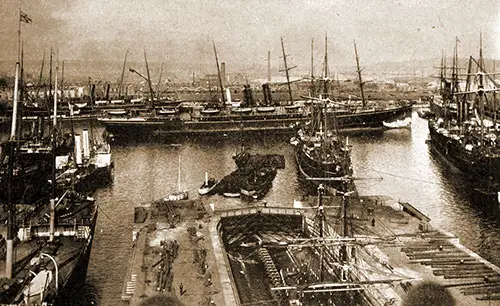
View of Outer Dock at Southampton in 1904. | GGA Image ID # 1756842782
1910s
American Line 1910s
- 1910-08-27 SS New York - Southampton to New York
- 1911-07-15 SS St. Paul - Southampton to New York
- 1911-08-16 SS St. Paul - Southampton to New York
- 1911-09-02 SS New York - Southampton to New York
- 1911-09-23 SS St. Louis - Southampton to New York
- 1912-09-21 SS St. Louis - Southampton to New York
- 1914-05-27 SS St. Paul - Southampton to New York
Atlantic Transport Line 1910s
Cunard Line 1910s
Hamburg American Line / Hamburg Amerika Linie (HAPAG) 1910s
North German Lloyd / Norddeutscher Lloyd 1910s
Union-Castle Line 1910s
White Star Line 1910s
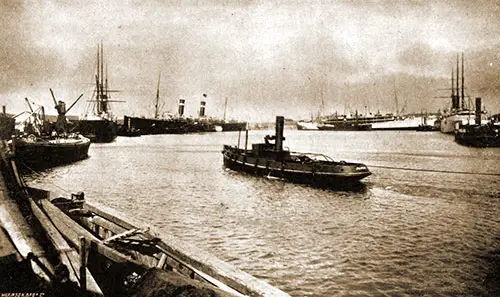
Empress Dock at Southampton in 1907. | GGA Image ID # 1756baa623
1920s
Aberdeen Line 1920s
American Line 1920s
Canadian Pacific Line - 1920s
- 1924-08-14 SS Empress of Scotland - Hamburg to Québec
- 1926-06-30 SS Melita - Antwerp to Québec and Montréal
- 1928-07-14 SS Empress of Australia - Southampton to Québec
- 1928-08-18 SS Empress of France - Southampton to Québec
- 1929-07-20 SS Empress of Scotland - Southampton to Québec
- 1929-09-07 SS Montroyal - Southampton to Québec
Cunard Line 1920s
- 1921-04-30 RMS Mauretania - Southampton to New York
- 1921-06-25 RMS Aquitania - Southampton to New York
- 1922-08-12 RMS Aquitania - Southampton to New York
- 1923-05-05 RMS Berengaria - Southampton to New York
- 1923-06-08 RMS Andania - Southampton to Québec and Montréal
- 1923-08-25 RMS Berengaria - Southampton to New York
- 1923-09-15 RMS Berengaria - Southampton to New York
- 1923-11-03 RMS Aquitania - Southampton to New York
- 1923-12-12 RMS Berengaria - Southampton to New York
- 1924-05-24 RMS Berengaria - Southampton to New York
- 1924-06-18 RMS Aquitania - New York to Southampton
- 1924-07-10 RMS Antonia - Cherbourg to Québec and Montréal
- 1924-07-26 RMS Aquitania - Southampton to New York
- 1924-08-01 RMS Andania - Southampton to Québec and Montréal
- 1925-05-06 RMS Andania - Hamburg to Halifax and New York
- 1925-08-15 RMS Ausonia - Southampton to Québec and Montréal
- 1925-08-15 RMS Berengaria - Southampton to New York
- 1927-11-26 RMS Aquitania - Southampton to New York
- 1928-09-26 RMS Mauretania - New York to Southampton
- 1929-03-20 RMS Berengaria - Southampton to New York
- 1929-05-18 RMS Aquitania - Southampton to New York
- 1929-06-19 RMS Aquitania - New York to Southampton
- 1929-07-16 RMS Berengaria - New York to Southampton
- 1929-08-10 RMS Aquitania - Southampton to New York
- 1929-08-24 RMS Tuscania - Southampton to New York
- 1929-08-31 RMS Aquitania - Southampton to New York
- 1929-09-07 RMS Berengaria - Southampton to New York
Hamburg American Line / Hamburg Amerika Linie (HAPAG) 1920s
- 1926-01-28 SS Albert Ballin - Hamburg to New York
- 1926-07-30 SS Deutschland - Hamburg to New York
- 1926-08-27 SS Albert Ballin - Hamburg to New York
- 1926-12-10 SS Cleveland - Hamburg to New York
- 1927-07-06 SS Albert Ballin - New York to Hamburg
- 1927-07-30 SS Reliance - Hamburg to New York
- 1927-08-12 SS Deutschland - Hamburg to New York
- 1927-08-16 SS Resolute - Hamburg to New York
- 1927-09-23 SS Deutschland - Hamburg to New York
- 1928-10-12 SS Deutschland - Hamburg to New York
- 1929-01-16 SS New York - Hamburg to New York
- 1929-03-15 SS Hamburg - Hamburg to New York
- 1929-04-05 SS New York - Hamburg to New York
Holland-America Line 1920s
- 1923-05-23 TSS Veendam - Rotterdam to New York
- 1924-04-15 TSS Rotterdam - Rotterdam to Halifax and New York
- 1924-05-21 TSS Rotterdam - Rotterdam to New York
- 1924-11-12 TSS Rotterdam - Rotterdam to New York
- 1925-09-02 TSS Rotterdam - Rotterdam to New York
- 1926-07-20 TSS Rotterdam - Rotterdam to New York
- 1926-08-03 TSS Veendam - Rotterdam to New York
- 1926-08-25 TSS Rotterdam - Rotterdam to New York
- 1928-08-07 TSS Veendam - Rotterdam to Halifax and New York
- 1929-05-29 TSS Rotterdam - Rotterdam to New York
- 1929-08-13 TSS Nieuw Amsterdam - Rotterdam to Halifax and New York
- 1929-08-23 TSS Statendam - Rotterdam to New York
- 1929-09-04 TSS Volendam - Rotterdam to New York
- 1929-09-11 TSS Rotterdam - Rotterdam to New York
North German Lloyd / Norddeutscher Lloyd 1920s
- 1924-08-26 SS Stuttgart - Bremen to New York
- 1926-04-08 SS Columbus - Bremen to New York
- 1927-01-16 SS Columbus - Bremen to New York
- 1927-05-11 SS Stuttgart - Bremen to New York
- 1927-05-29 SS Columbus - Bremen to New York
- 1927-08-27 SS Stuttgart - Bremen to New York
- 1928-06-30 SS Sierra Cordoba - New York to Bremen
- 1928-07-26 SS Karlsruhe - Bremen to New York
- 1928-07-28 SS Columbus - Bremen to New York
- 1928-09-22 SS Columbus - Bremen to New York
- 1928-10-20 SS Columbus - Bremen to New York
- 1928-11-15 SS Columbus - Bremen to New York
- 1929-04-13 SS Columbus - Bremen to New York
- 1929-09-04 SS Bremen - Bremen to New York
Red Star Line 1920s
- 1920-04-21 RMS Lapland - Antwerp to New York
- 1923-08-08 SS Lapland - Antwerp to New York
- 1926-08-27 SS Pennland - Antwerp to Halifax and New York
- 1926-09-03 SS Belgenland - Antwerp to New York
- 1928-07-27 SS Pennland - Antwerp to Halifax and New York
- 1928-08-31 SS Lapland - Antwerp to New York
- 1929-08-16 SS Arabic - Antwerp to Halifax and New York
Royal Mail Steam Packet Company (R.M.S.P.) 1920s
- 1921-10-22 SS Orbita - Hamburg to New York
- 1922-03-31 SS Orbita - New York to Hamburg
- 1922-07-26 SS Orduña - London to New York
- 1923-03-27 SS Orduña - Hamburg to Bermuda and New York
- 1923-08-01 SS Orbita - Hamburg to New York
- 1923-08-29 SS Ohio - Hamburg to New York
- 1923-12-19 SS Orca - Hamburg to New York
- 1924-07-06 SS Orca - Hamburg for Québec and New York
- 1924-07-22 SS Ohio - Hamburg to New York
- 1924-07-29 SS Orbita - Hamburg to New York
- 1924-10-08 SS Orbita - Hamburg to New York
- 1926-06-19 SS Orca - New York to Southampton
- 1926-07-30 SS Orca - Southampton to New York
- 1926-09-17 SS Ohio - Cherbourg to New York
Union-Castle Line 1920s
United American Lines (Harriman Line) 1920s
- 1922-09-05 SS Resolute - Hamburg to New York
- 1922-11-15 SS Reliance - Hamburg to New York
- 1923-07-10 SS Reliance - Hamburg to New York
- 1923-07-24 SS Resolute - Hamburg to New York
- 1923-10-21 SS Cleveland - Hamburg to New York
- 1925-05-08 SS Cleveland - Hamburg to New York
- 1925-05-19 SS Resolute - Hamburg to New York
- 1925-06-30 SS Resolute - New York to Hamburg
- 1925-07-14 SS Reliance - New York to Hamburg
- 1925-09-08 SS Resolute - Hamburg to New York
United States Lines 1920s
- 1922-07-12 SS America - Bremen to New York
- 1922-10-04 SS President Harding - Bremen to New York
- 1923-01-06 SS President Harding - Bremen to New York
- 1923-10-19 SS President Arthur - Bremen to New York
- 1924-02-22 SS America - Bremen to New York
- 1924-07-27 SS America - Bremen to New York
- 1924-08-05 SS Leviathan - Southampton to New York
- 1924-08-22 SS George Washington - Bremen to New York
- 1924-09-19 SS George Washington - Bremen to New York
- 1924-09-29 SS America - Bremen to New York
- 1925-07-25 SS Leviathan - New York to Southampton
- 1925-08-05 SS America - Bremen to New York
- 1925-08-25 SS Leviathan - Southampton to New York
- 1925-09-23 SS George Washington - Bremen to New York
- 1926-08-10 SS Leviathan - Southampton to New York
- 1926-09-08 SS President Harding - Bremen to New York
- 1926-09-21 SS Leviathan - Southampton to New York
- 1926-09-24 SS Republic - Bremen to New York
- 1927-03-16 SS President Harding - Bremen to New York
- 1927-04-19 SS Leviathan - Southampton to New York
- 1927-06-21 SS Leviathan - Southampton to New York
- 1927-10-11 SS Leviathan - Southampton to New York
- 1928-03-13 SS Leviathan - Southampton to New York
- 1928-05-04 RMS Ausonia - Southampton to Québec and Montréal
- 1928-06-05 SS Leviathan - Southampton to New York
- 1928-06-06 SS George Washington - Bremen to New York
- 1928-07-18 SS President Harding - Bremen to New York
- 1929-09-29 RMS Ausonia - Southampton to Québec and Montréal
- 1929-03-30 SS Leviathan - Southampton to New York
- 1929-08-27 SS Leviathan - Southampton to New York
White Star Line 1920s
- 1920-04-07 RMS Adriatic - Southampton to New York
- 1920-04-24 SS Adriatic - New York to Southampton
- 1920-09-08 RMS Olympic - Southampton to New York
- 1922-08-23 RMS Olympic - Southampton to New York
- 1922-09-06 RMS Majestic - Southampton to New York
- 1923-09-05 RMS Homeric - Southampton to New York
- 1924-05-07 RMS Majestic -Southampton to New York
- 1924-05-22 SS Pittsburgh - Hamburg to New York
- 1924-06-04 RMS Olympic - Southampton to New York
- 1924-09-04 SS Pittsburgh - Hamburg to New York
- 1924-09-18 RMS Arabic - Hamburg to New York
- 1925-04-04 SS Homeric New York to Southampton
- 1925-05-27 RMS Homeric - Southampton to New York
- 1926-06-05 SS Majestic - New York to Southampton
- 1926-08-25 RMS Homeric - Southampton to New York
- 1927-08-24 RMS Majestic - Southampton to New York
- 1928-06-14 RMS Albertic - Montréal and Québec to London
- 1928-08-08 RMS Homeric - Southampton to New York
- 1928-08-15 RMS Majestic - Southampton to New York
- 1929-04-20 SS Majestic - New York to Southampton
- 1929-09-04 RMS Majestic - Southampton to New York
- 1929-09-18 RMS Homeric - Southampton to New York
Note: Typically, only the origination and final destination ports are listed in each link. Other intermediary ports of call are not listed.
The Port of Southampton
For centuries, the Port of Southampton has been the scene of sea-going activity; thus, from the earliest days, it has been a trading center. Throughout the ages, the port has been found most conveniently placed for developing the "Old Country maritime business."
The Outer Dock
Southampton has an incomparable estuary leading from the Solent to the very walls of the town. This estuary is about six miles long, one mile wide, landlocked, and sheltered throughout.
The crowning gift, however, is the formation of the Isle of Wight off the entrance to Southampton Water, causing the phenomenon of double tides whereby the period of high water is extended to about two hours each tide, during which there is practically no tidal flow or fall.
With these favorable conditions, the first stone of the initial dock, the Outer Dock, was laid on Friday, 12 October 1838, and was opened for traffic on 20 August 1842. The quays, which have adequate rail facilities, are equipped with commodious sheds for the reception of passengers and merchandise and cranes worked by electric or hydraulic power.
One berth is provided with steam sheers of 80 tons lifting capacity. Within easy proximity of this dock are tine warehouses, equipped with modern electric hoists for housing coffee, cocoa, sugar, tobacco, ci pars, dried fruits, etc., and vaults for the cool storage of wines and semi-perishable produce.
The Inner Dock
It soon became apparent by the success of this first venture that the construction of a further dock must be undertaken, with the result that the Inner Dock was built, being opened in 1851. This is the only basin at Southampton which is not tidal, being approached by lock gates from the Outer Dock.
This dock is now the center of the grain and fruit trades. On the North and East quays are fantastic grain warehouses furnished with modern machinery, including elevator equipment, with a capacity for discharging 100 tons per hour, making it possible for the largest grain cargoes to be expeditiously handled. These warehouses have commodious dry vaults for housing wines, spirits, and other goods.
Other Facilities Installed
In 1866, the River Quay on the west side of the Itchen was opened for traffic. It provides four berths for large ocean-going liners, equipped with four commodious sheds adapted for the reception of passengers and cargo.
At these berths, the cargoes landed from the Canadian Pacific steamships are expeditiously handled and distributed to various parts of the kingdom.
Empress Dock, the last extension undertaken by the late Southampton Dock Company, was opened on Saturday, 26 July 1890, by her late Majesty, Queen Victoria, and named her Empress Dock.
In 1907, given the number of shipping companies attracted to Southampton, and the traffic that would undoubtedly follow, the 16-acre open dock, named the Ocean Dock, was commenced and opened for traffic in 1911. This dock now accommodates the world's largest liners.
Gilbert S. Szlumper, "The Port of Southampton," in World Ports, Vol. XII, No. 1, November 1923, pp. 160-161, 163.
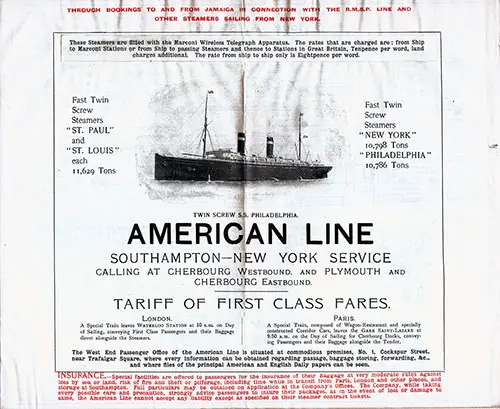
Southampton to New York Service 1908 - American Line - Tariff of First Class Fares. | GGA Image ID # 1757495e87
Related Categories
Steamship & Ocean Liners
- Adriatic
- Albert Ballin
- America
- Amerika
- Andania
- Antonia
- Aquitania
- Arabic
- Armadale Castle
- Ascania
- Auguste Victoria
- Ausonia
- Berengaria
- Bremen
- Carnarvon Castle
- Cincinnati
- Cleveland
- Columbus
- Demosthenes
- Deutschland
- Empress of Australia
- Empress of France
- Empress of Scotland
- Friedrich der Grosse
- Fürst Bismarck
- George Washington
- Hamburg
- Havel
- Homeric
- Kaiser Wilhelm der Grosse
- Kaiser Wilhelm II
- Kaiserin Maria Theresia
- Karlsruhe
- Konigin Luise
- Koning Wilhelm II
- Kronprinz Wilhelm
- Lahn
- Lapland
- Leviathan
- Majestic
- Mauretania
- Melita
- Minnehaha
- Mongolia
- Montroyal
- New York
- Nieuw Amsterdam
- Oceanic
- Ohio
- Orbita
- Orca
- Orduña
- Paris
- Pennland
- Philadelphia
- Pittsburgh
- President Harding
- President Lincoln
- Prinz Friedrich Wilhelm
- Reliance
- Republic
- Resolute
- Rotterdam
- Sierra Cordoba
- St. Louis
- St. Paul
- Statendam
- Stuttgart
- Teutonic
- Titanic
- Tuscania
- Veendam
- Volendam
- Walmer Castle
SS RMS MV - Defined
Ephemera & History
- Aberdeen Line
- American Line
- Atlantic Transport Line
- Canadian Pacific Line
- Cunard Line
- Hamburg American Line
- Holland-America Line
- North German Lloyd
- Red Star Line
- Royal Mail Steam Packet Company (R.M.S.P.)
- Union-Castle Line
- United American Lines (Harriman Line)
- United States Lines
- White Star Line
By Year of Voyage
- 1893
- 1895
- 1896
- 1897
- 1899
- 1900
- 1901
- 1902
- 1903
- 1904
- 1905
- 1906
- 1907
- 1908
- 1909
- 1910
- 1911
- 1912
- 1914
- 1919
- 1920
- 1921
- 1922
- 1923
- 1924
- 1925
- 1926
- 1927
- 1928
- 1929
By Port of Call
- Antwerp
- Bermuda
- Boulogne-sur-Mer
- Bremen
- Cherbourg
- Capetown
- Halifax
- Hamburg
- La Plata
- London
- Melbourne
- Montréal
- Natal
- New York
- Québec
- Rio de Janeiro
- Rotterdam
- Southampton
Ports of Call Information
⚠️ About Accuracy in Historical Records Research Tip
Context. The GG Archives presents passenger lists as faithfully as possible to the original documents. While OCR is generally accurate, portions of these collections—especially image captions and some transcriptions—are typed by hand and may include typographical or spelling variations. The original manifests themselves also contained clerical inconsistencies (names recorded phonetically, mid-voyage corrections, etc.).
What this means for your research:
- Search variant spellings of names (e.g., “Schmidt/Schmitt/Smith,” “Giuseppe/Joseph”).
- Cross-reference with immigration cards, passport applications, naturalization files, city directories, and newspapers.
- Treat manifests as primary sources with historical quirks—use them alongside corroborating records.
- For place names, consider historical borders and language variants (e.g., Danzig/Gdańsk, Trieste/Trst).
How to cite. When quoting a name from a manifest, consider adding [sic] for obvious misspellings and include a note such as “spelling as printed in original passenger list.”
Need help? If you spot a likely transcription error in captions, feel free to contact us with the page URL and a brief note—we love community input. 🙏
Curator’s Note
For over 25 years, I've been dedicated to a unique mission: tracking down, curating, preserving, scanning, and transcribing historical materials. These materials, carefully researched, organized, and enriched with context, live on here at the GG Archives. Each passenger list isn't just posted — it's a testament to our commitment to helping you see the people and stories behind the names.
It hasn't always been easy. In the early years, I wasn't sure the site would survive, and I often paid the hosting bills out of my own pocket. But I never built this site for the money — I built it because I love history and believe it's worth preserving. It's a labor of love that I've dedicated myself to, and I'm committed to keeping it going.
If you've found something here that helped your research, sparked a family story, or just made you smile, I'd love to hear about it. Your experiences and stories are the real reward for me. And if you'd like to help keep this labor of love going, there's a "Contribute to the Website" link tucked away on our About page.
📜 History is worth keeping. Thanks for visiting and keeping it alive with me.
